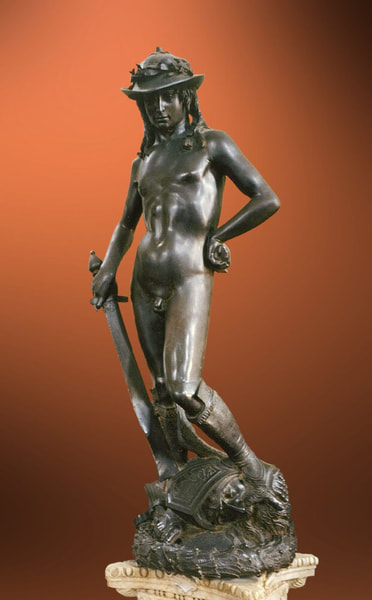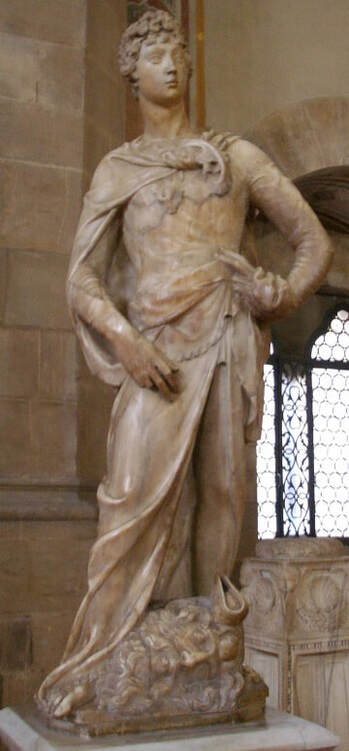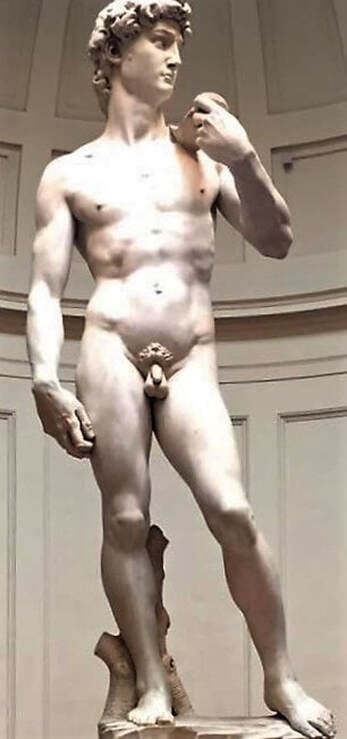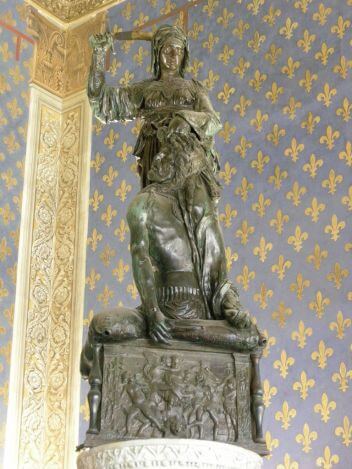|
Patrick A. Rodgers, CC BY-SA 2.0
Where? Room 7 on the first floor of the Bargello Museum
When? Uncertain, but sometime between 1425 and 1455 Commissioned by? Cosimo de’ Medici
Backstory: In 1408-1409, Donatello also created a sculpture of David. This marble sculpture, however, is clothed and can also be found in the Bargello. According to Vasari, the pedestal for the bronze statue of David is probably created by Desiderio da Settignano. This statue is the oldest surviving bronze since antiquity. Bronze was perceived to be the most precious metal after gold, and therefore it was considered to be a special statue.
Inscription: The base of this statue carried a Latin inscription, which can be translated as: “The victor is whoever defends the fatherland. God crushes the wrath of an enormous foe. Behold - a boy overcame a great tyrant! Conquer, O citizens! Kingdoms fall through luxury, cities rise through virtues. Behold the neck of pride, severed by the hand of humility.” This inscription was intended to remind the Medici family of how to reign Florence.
Symbolism: This statue symbolized the victory of humility (represented by David) over tyranny (represented by Goliath). The Medici family displayed this statue in the courtyard of the Medici Palace to remind them and others of their humility and strength, but also to justify potential violence against people who were against their regime. The statue was placed footsteps away from the famous Judith and Holofernes statue by Donatello which can now be admired in the Palazzo Vecchio. The cupids on the helmet of Goliath are a symbol of non-religious passion and are a reference to the pagan people who are defeated by God. The wreath of laurel on David’s head is an indication of his victory over Goliath.
Who is Donatello? Donato di Niccolò di Betto Bardi (c. 1386-1466), better known as Donatello, was born in Florence. He was a sculptor that was ahead of his time. He was initially trained in a workshop of a goldsmith. Early in his career he worked together with and learned from Lorenzo Ghiberti and Filippo Brunelleschi. He has created statues and reliefs using materials such as bronze, stone, wax, and wood. Together with Leonardo da Vinci, Michelangelo, and Raphael, he is considered to be one of the four greatest artists of the Renaissance.
Fun fact: It is assumed that Donatello was homosexual and some people argue that he created this nude statue of David deliberately in a daring erotic posture. The left wing of the helmet that runs all the way up the right leg of David until the groin is interpreted as another sign that this is a homoerotic statue. Homosexuality, however, was forbidden during that time in Florence, but Donatello’s good friend Cosimo de’ Medici defended him from insults and the law. Cosimo was known to appreciate very talented artists and therefore he overlooked some of the bad behaviors that they may display. Interested in a copy for yourself? Poster, canvas, or statue (Amazon links).
Written by Eelco Kappe
References:
0 Comments
Leave a Reply. |
Categories
All
|
- Home
- Blog
-
Museums
- Alte Pinakothek
- Art Institute of Chicago
- Baltimore Museum of Art
- Barber Institute of Fine Arts
- Bargello
- Barnes Foundation
- British Museum
- Church of Sant’Anastasia
- Cleveland Museum of Art
- Courtauld Institute of Art
- Detroit Institute of Arts
- Frans Hals Museum
- Galleria Borghese
- Gallerie dell'Accademia
- Getty Museum
- Guggenheim
- Hermitage Museum
- Kunsthistorisches Museum
- Kunstmuseum Basel
- Legion of Honor Museum
- Louvre
- Mauritshuis
- Metropolitan Museum of Art
- Musee d’Orsay
- Museum of Fine Arts in Boston
- Museum of Modern Art
- National Gallery in London
- National Gallery of Art
- National Museum in Poznań
- Norton Simon Museum
- Ny Carlsberg Glyptotek
- Palace of Versailles
- Palazzo Pitti
- Palazzo Vecchio
- Petit Palais
- Philadelphia Museum of Art
- Prado
- Pushkin Museum
- Ravenna Art Museum
- Rijksmuseum
- San Diego Museum of Art
- Santa Maria delle Grazie
- St. Peter's Basilica
- Städel Museum
- Statens Museum for Kunst
- Tate Britain
- Tate Modern
- Timken Museum of Art
- Uffizi
- Vatican Museums
- Wallace Collection
-
Artists
- Altdorfer
- Anguissola
- Berlin Painter
- Bosch
- Botticelli
- Boucher
- Bronzino
- Bruegel the Elder
- Brunelleschi
- Cabanel
- Caillebotte
- Canova
- Caravaggio
- Carpeaux
- Cezanne
- Cimabue
- David
- Degas
- Delacroix
- De Maria
- Donatello
- El Greco
- Fontana
- Fra Angelico
- Fragonard
- Gauguin
- Gentileschi
- Gericault
- Gonzalez-Torres
- Goya
- Hals
- Hogarth
- Hokusai
- Ingres
- Leonardo da Vinci
- Lippi, Filippo
- Longhi, Barbara
- Lorrain
- Makovsky
- Manet
- Massys
- Matisse
- Merian
- Michelangelo
- Mochi
- Modigliani
- Monet
- Panini
- Parmigianino
- Perugino
- Picasso
- Pisanello
- Raphael
- Rembrandt
- Renoir
- Reynolds
- Rivera
- Rodin
- Rubens
- Scultori
- Seurat
- Steen
- Tintoretto
- Titian
- Toulouse-Lautrec
- Turner
- Uccello
- Van der Weyden
- Van Dyck
- Van Eyck
- Van Gogh
- Van Hemessen
- Vasari
- Velazquez
- Vermeer
- Veronese
- Vigée Le Brun
-
Locations
- Books
- About Us




